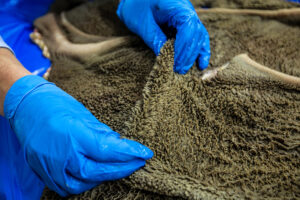There are 2 types of rumen acidosis: subacute rumen acidosis (SARA) and acute rumen acidosis. Subacute rumen acidosis occurs when the balance in the rumen is disturbed, and the pH has dropped between 5.5 and 5.0. Main culprit of the increased acidity is the Streptococcal bacteria. When these lactic acid producing bacteria increase, the pH drops further, and eventually cause acute rumen acidosis.
Acidosis

Rumen acidosis is one of the most prevalent metabolic diseases among dairy cows. At the same time it is often inconspicuous. Litres of milk are lost due to a reduced absorption of nutrients causing millions in damage around the world. In addition, it has a negative effect on the cows overall condition, which can lead to more health problems. The most common health problems associated with rumen acidosis are; uterine infections, reduced fertility, increased cell count and hoof problems.
In subacute rumen acidosis, an excess of acid is formed in the rumen. These destroy the rumen microbes. Rumen microbes are valuable nutrients for the cow and produce volatile fatty acids: propionic acid, acetic acid and butyric acid. A cow with subacute rumen acidosis can be recognised by reduced rumination activity, diarrhoea, reduced condition, low dry matter intake, reduction in milk fat content, undigested residues in the manure and hoof problems.
In acute rumen acidosis, the rumen environment becomes increasingly favourable for bacteria that produce large amounts of lactic acid. The acid affects the rumen wall, reducing the absorption capacity of the rumen. In acute acidosis, the dry matter intake decreases further, and the rumination activity decreases.
Determining the pH of rumen fluid is the most accurate way of diagnosing acidosis. However, obtaining rumen samples with a stomach tube will give inaccurate results due to contamination with saliva and its buffers. The recommended method of collection is rumenocentesis (the puncture of the rumen through the abdominal wall and through probe) which can easily be done by a veterinarian.
During necropsy, rumen acidosis can be identified by discoloured (black) rumen papillae. The overdevelopment of the rumen papilla is also an often found.
If the rumen pH is too low, the increase of starch in the ration is recommended. This can be done by feeding potato fibre. Corn, on the other hand, is not a good alternative. Maize is starchy, but it is also a feed source that acidifies quickly in the silage. As a result, the risk of rumen acidosis increases when the proportion of maize in the ration increases.
Feed structure does ensure a good rumen pH and the efficient digestion. More structure in the feed leads to more rumination, which leads to more saliva. Saliva has a buffering effect in the rumen and therefore neutralizes the rumen acids. Sufficient structure ensures that the ration is digested less quickly. Alfalfa can be added to the ration for extra structure.
The addition of buffers has a beneficial effect on the feed intake and the functionality of the rumen. A buffer ensures that the rumen acids are stabilised. An example of a commonly used buffer is sodium bicarbonate. Finally, the type of concentrated feed can be adjusted, or distiller grains can be added to the ration.

